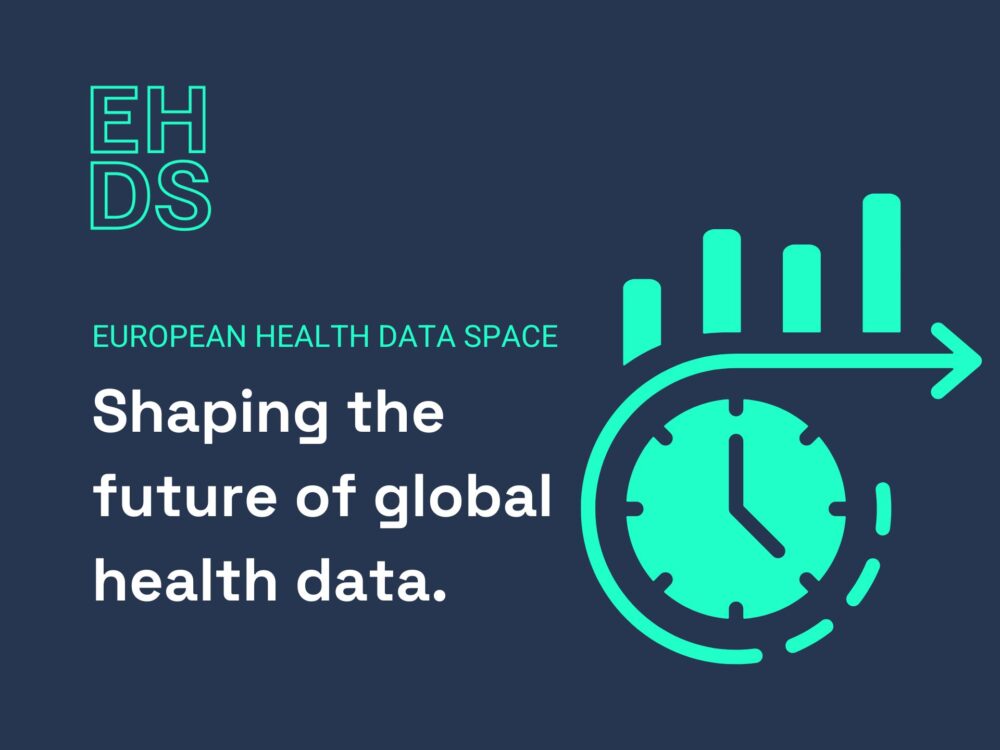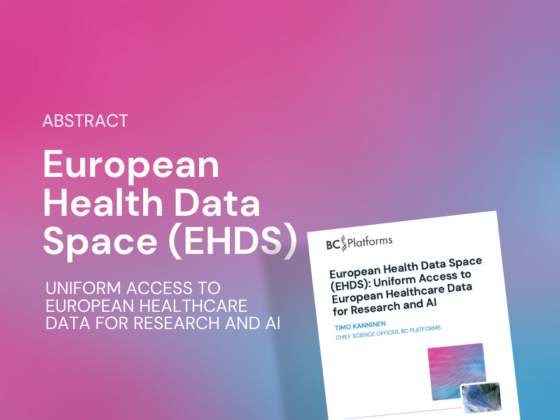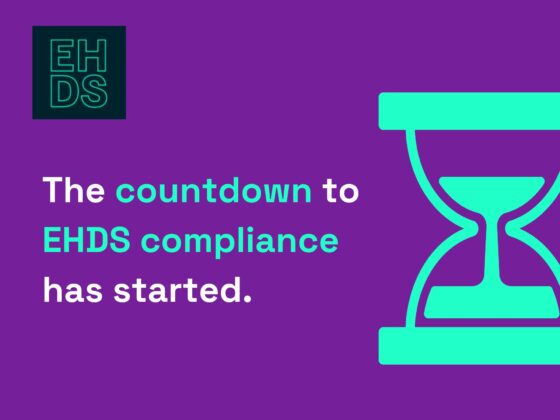
By Timo Kanninen, CSO, BC Platforms
Today is the start of a new era in European healthcare data access and management with the new EHDS Regulations coming into force – the countdown begins!
The initial requirements for EHDS across all EU member states will need to be in place starting on this date in 3 years’ time (2028), with additional milestones in 2029 and 2031. Our CSO, Timo Kanninen, tells us more about what EHDS means and how it will transform the sharing of healthcare data in Europe.
To-date, the main challenges in the health data space have been related to data access and control – whether it be patients, healthcare professionals, researchers or policymakers. Providers of digital health services have faced numerous barriers, while products and limited access to health data have stifled research and innovation. The Covid-19 pandemic ultimately brought these challenges to the forefront, highlighting a pressing need for greater collaboration among European countries to better safeguard health.
In 2020, the European Strategy for data boldly set out Europe’s goal to become a global leader amongst the world’s data-driven societies. Ten European common data spaces were identified at that time, including health. Overall, it was projected that up to €120 billion could be saved through more efficient use of data.
Formation of the European Health Data Space (EHDS)
In 2022, the recognition of a critical need for collaboration led to the European Commission’s proposal for the formation of a European Health Data Space (EHDS). The EHDS identifies digital transformation as critical to providing better healthcare to citizens by facilitating research and innovation. After two years of discussions, EHDS was finally approved in the spring of 2024 by the European Parliament – 445 voting in favor and 142 against – as well as the European Council.
The resulting EHDS is the largest European healthcare initiative in history, integrating half a billion EU citizens into a unified network of electronic health data. It is set to profoundly impact healthcare and health research in Europe and abroad. In brief, EHDS is a legislative framework for mandatory healthcare data governance in the EU that includes rules, common standards and practices, and infrastructures. The legislation applies to electronic health records (EHR), health data from apps and medical devices, and health data in registries.
The impact of EHDS
With Europe’s diverse population, EHDS presents an incredible opportunity to analyze real-world healthcare data and generate robust real-world evidence for research, innovation and governance. The ‘Brussels Effect’ – the influence of European policy and legislative frameworks on standards in other countries and regions internationally – has been documented on several occasions, including GDPR after those regulations came online. It is, therefore, possible that EHDS will eventually become a global benchmark for healthcare data access and sharing.
EHDS will alter the current health data landscape
EHDS aims to advance digital health for all Member States and is designed to protect and streamline health data impacting primary use (healthcare-focused) and secondary use (research-focused). These regulations will replace existing national legislation that controls healthcare data sharing and usage.
At present, accessing healthcare data in Europe for analysis purposes varies by country, and cross-border data sharing can be very difficult. EHDS is revolutionizing healthcare research and introduces standard processes for data availability queries, processing data access applications, and releasing pseudonymized or anonymized data to secure processing environments (SPE) for federated data analysis, compliant with the current GDPR legislation.
EHDS will link national health data access bodies to decentralized healthcare data portals for primary use (MyHealth@EU) as well as secondary use. This will create a trustworthy environment in which high-quality data can be shared beyond the original patient care pathway making anonymized health data available for research and innovation. The implementation of EHDS, together with the growing need for RWD data, is expected to significantly increase incoming data requests.
The role of health data access bodies
Given that health data companies already have the user interface and data analysis tools available to interrogate health data, these will in future be able to interact with the national health data access bodies to support data queries and responses for secondary use. While the EU has yet to publish the standard templates for data queries, expected within the next two years, EHDS regulation currently defines requirements on a high level.
It is worth noting that the national health data access bodies seldom have direct access to health data but rather act as logistic hubs handling data queries and access applications and providing a secure processing environment for data access in addition to other institutions. To reduce data application processing workloads, healthcare institutions equipped with ethics committees e.g. university hospitals (trusted data holders) can approve data access concerning their own data. For non-university hospitals (non-trusted data holders), the national health data access bodies will be responsible for approving queries.
National health data access bodies can receive and process two types of data enquiries. The first type of query must be answered by aggregate data e.g. to show how many matches meet the requested inclusion or exclusion criteria, and the second query, once approval has been granted, provides access to pseudonymized data meeting the requested criteria in secure processing environment. Data can also be used for federated analyses or given to researchers in a fully anonymized format.
Industry players will need to adapt to EHDS
With EHDS, queries will now be directed through national health data access bodies, which then link to the respective healthcare data sources. This will impact data partner networks and drastically change how companies go about requesting and accessing data for users within the EU, and eventually, those that are based outside of the EU. The unified data network, under the EHDS framework, will make accessing data easier, with the number of queries directed at hospitals with high quality data expected to grow by 10-100 times. If not well prepared, health data access bodies and hospitals may become a research bottleneck at the whole country level.
EHDS readiness among EU Member States varies widely given how they organize and manage health data and the level of digitalization of health data. This presents opportunities to attract research collaboration projects from less prepared member states.
Moving from zero to EHDS readiness
The European healthcare market consists of more than 200 university hospitals, 15,000 non-university hospitals and 100 large commercial healthcare enterprises. Connecting this market through EHDS means that more and more healthcare data will be processed in the cloud.
In addition to the physical infrastructure required, trusted research environments (TREs) will often need to connect to the cloud to provide enough capacity e.g. for AI-related work. Over the next two years, the EU will publish the EHDS technical specifications for secure processing environments for analyzing pseudonymized data, like those already in place in Finland. BC Platforms provides European university hospitals and healthcare institutions with the fundamental digital building blocks to construct a robust, foundation for EHDS2 readiness over the next 2–6 years, ensuring efficient data sharing for research and innovation while adhering to stringent EU regulations.
To support the requirements of EHDS, at BC Platforms we are actively involved in the TEHDAS2 consortium, which is developing guidelines and technical specifications for implementation of secondary healthcare data use.
BC Platforms’ offering delivers EHDS-compatible modular and scalable solutions ranging from individual hospital implementations to national-scale systems. BC Platforms’ EHDS-ready TRE, for example, is hardware-agnostic and can be installed on national clouds or for localized use on-premises, thereby facilitating cross-EU connections through automation and streamlining of complex workflows.
By supporting EHDS readiness and delivering EHDS-ready platforms and tools of the future, our team at BC Platforms is helping ensure that the EU becomes competitive against US and Asian countries especially in healthcare AI related research and innovation work.
Learn more about EHDS here.
Read more about the EU TEHDAS2 project here.


